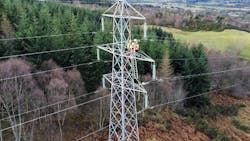SSEN Transmission Implementing Dynamic Line Rating Network in the UK
SSEN Transmission is implementing dynamic line rating (DLR) network in the UK for increasing wind power transmission capacity and to make the GB electricity grid more efficient.
The company has installed the technology across over 300 km of overhead transmission lines as part of its north of Beauly DLR project, which is expected to be operational by the end of 2025.
DLR uses real‑time environmental data, including temperature, wind speed, solar radiation, and cloud cover to calculate the true, live capacity of overhead lines as compared to static line ratings, which are fixed conservative ratings leaving capacity unused. High winds cool lines, enabling higher power voltages to flow safely, with DLR.
The sensors transmit live conductor temperatures to cloud-based algorithms. The algorithms calculate real-time and forecast ratings, which are communicated to the National Energy System Operator (NESO), which uses the data in making decisions to balance generation and manage potential constraint on the network.
DLR provides a boost to the grid that, working alongside reinforcement, helps maximize efficiency across the network and save energy consumers costs, by easing constraints.
“With all sensors now installed, a rigorous period of calibration and monitoring will now take place over the coming months,” said Brant Wilson, SSEN Transmission’s Innovation Portfolio Manager. “After that, SSEN Transmission and NESO will work together to perform communication testing, aiming to roll out the system for full operation by the end of the year."
